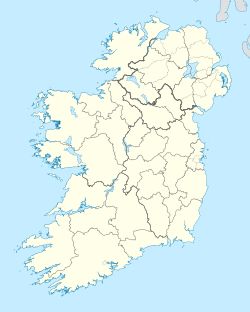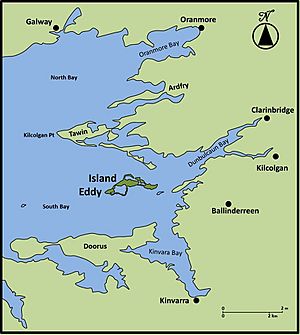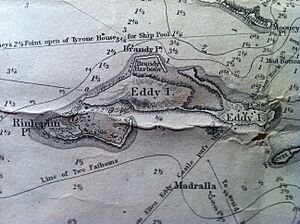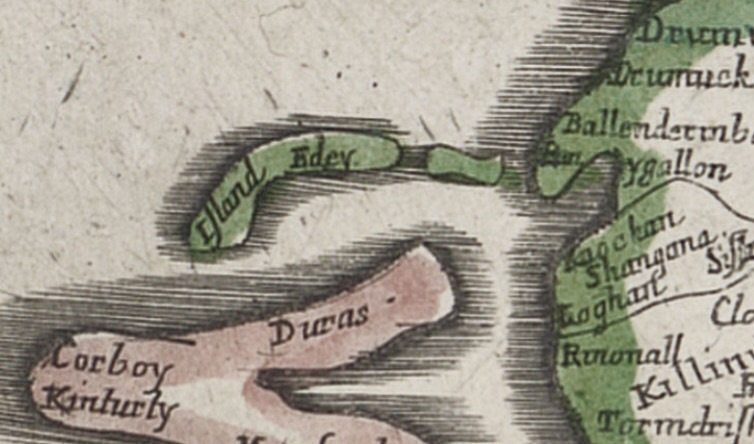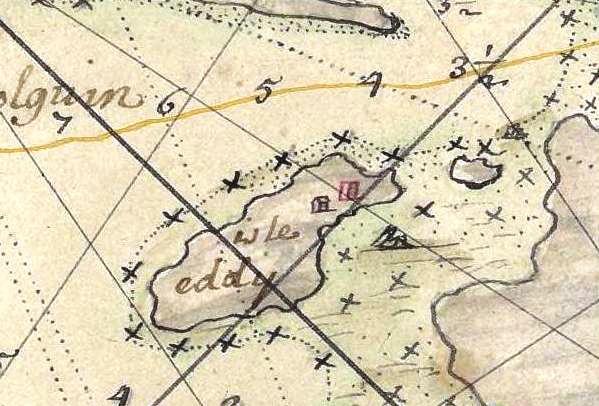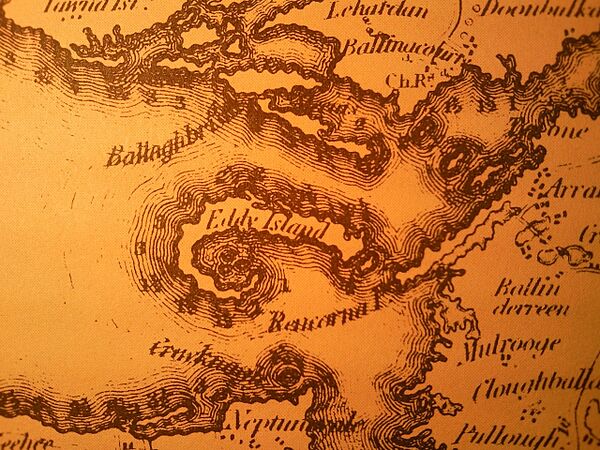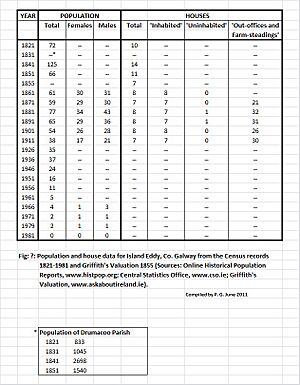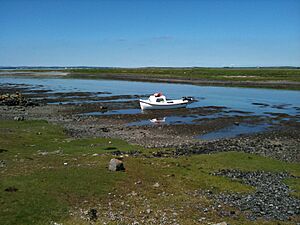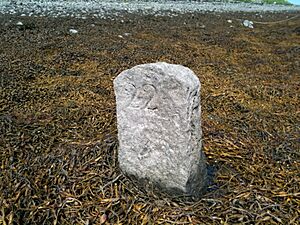Island Eddy facts for kids
|
Native name:
Oileán Eide
|
|
|---|---|
| Geography | |
| Location | Atlantic Ocean |
| Coordinates | 53°12′N 8°59′W / 53.2°N 8.99°W |
| Highest elevation | 8 m (26 ft) |
| Administration | |
| Province | Connacht |
| County | Galway |
| Demographics | |
| Population | 0 |
Island Eddy is a small island located at the eastern end of Galway Bay in Ireland. It used to have people living on it, but now it is empty.
Contents
What's in a Name?
Locally, people always call the island 'Island Eddy', not 'Eddy Island'. The Irish government's official group for place names agrees with this. Its name in Irish is 'Oileán Eide'. Don't confuse it with Islandeady, which is a village far from the coast in County Mayo.
Where is Island Eddy?
Geographical Location
Island Eddy is on the west coast of Ireland, deep inside Galway Bay. The closest town is Kinvara, which is about 7 kilometers (4.3 miles) to the south-east.
Administrative Location
Island Eddy is part of:
What Does the Island Look Like?
Island Eddy is made up of three low pieces of land. These are connected by long, narrow strips of land and stone. At the south-west end, some of these strips form a large, calm water area, like a lagoon. Another similar area is found towards the eastern end. Locals call these areas "Malluirs". They fill and drain with the tide, but a bit slower than the rest of the bay.
The main parts of the island are probably small hills left behind by glaciers. The connecting strips are mostly made of smooth, rounded stones and shingle from the sea. At the very east end of the island, there's a long, winding sand spit called "the cush". You can walk across this spit to the island at certain low tides.
The island is about 2.85 kilometers (1.77 miles) long from east to west. It is about 1.05 kilometers (0.65 miles) wide from north to south. The highest point on the island is about 8 meters (26 feet) above sea level.
Map Gallery
Who Owned the Island?
Over the centuries, different people and groups owned parts of Island Eddy:
- In 1574, the Bishop of Kilmacduagh owned it.
- By 1641, Sir Roebuck Lynch Bart owned most of it.
- In 1667, Dr. Robert Gorges was the owner.
- By 1855, Sir Thomas N. Redington owned the island.
Today, different local families from the mainland own the enclosed land and house plots on the island.
How Many People Lived Here?
We don't know exactly how many people lived on Island Eddy before the 1800s. But the good land and lots of seafood like seaweed and shellfish suggest people probably lived there for a very long time.
The island's population reached its highest point in 1841, with 125 people. However, during the Great Famine (1845–1849), the population dropped by half. It recovered a little in the 1870s but then slowly declined. The island's school closed around 1901, which was a big loss for the community.
Even though many people left, the community kept going until just before World War II. The last two people living on Island Eddy left in December 1980.
| Historical population | ||||||||||||||||||||||||||||||||||||||||||||||||||||||||||||||||||||||||||||||||
|---|---|---|---|---|---|---|---|---|---|---|---|---|---|---|---|---|---|---|---|---|---|---|---|---|---|---|---|---|---|---|---|---|---|---|---|---|---|---|---|---|---|---|---|---|---|---|---|---|---|---|---|---|---|---|---|---|---|---|---|---|---|---|---|---|---|---|---|---|---|---|---|---|---|---|---|---|---|---|---|---|
|
|
|
||||||||||||||||||||||||||||||||||||||||||||||||||||||||||||||||||||||||||||||
| Source: | ||||||||||||||||||||||||||||||||||||||||||||||||||||||||||||||||||||||||||||||||
Island Families
Several family names are strongly connected to Island Eddy's history over the last two hundred years. The main families in the 1800s and 1900s were the Berminghams, Conlons, Keanes, and Hynes. Other families like the Corless, Fitzgerald, and Finnegan families also lived there.
The earliest people recorded as living on Island Eddy were Richard fitz James Skeret, Walter Perrell, and Henry Perrell in 1552. They were mentioned in a document about the island's castle. The Perrell family lived on Island Eddy for at least four generations, from the early 1500s to the 1640s.
Even though no one lives on the island now, descendants of the former residents are still in touch through social media.
Glimpses of History
- The earliest mention of Island Eddy found so far is from the year 1225. A historical account describes a raid that took place, saying it "left not a four-footed beast from Island-Eddy to Athenry."
- A castle on the island was first mentioned in a document from August 1552. This document talked about property on Island Eddy, including "the house or parte of Castell that belongethe to Richard."
- In 1574, the castle on "Iland Eddie" was owned by Henry Parell.
- A school was opened on the island in November 1877 by the Redington family, who owned the island. The school was a single room with a thatched roof and an earthen floor. In May 1879, 34 students were enrolled. The school likely closed around 1901.
- In 1926–27, the island community had a disagreement with the local government about high land taxes. This led to a boycott where they refused to pay the taxes.
Island Archaeology
The Village Ruins
The most noticeable old structures are the ruined houses, or "village," at the east end of the island. On an old map from 1842, there were 41 buildings with roofs. By 1915–16, this had changed to 36 buildings, divided into 7 areas.
The Castle Site
The castle mentioned in historical records (from 1552 and 1574) was located at the eastern end of the village. Today, only a large piece of stone wall remains. We don't know exactly when the castle was destroyed.
Children's Burial Ground
There is also a special burial ground for children on the southern edge of the village. It has one gravestone that says, "Eliza Murphy Who died 8 April AD 1827 aged 17 Months."
Boat Nausts
An amazing series of boat shelters, called Nausts, have been found in the North Mallmhuir. There are 15 clear nausts and one possible one along 115 meters (377 feet) of the shoreline. These shelters, known locally as 'cloches', provided safe places for the island's boats. The number and size of these nausts are unique in Ireland.
Seaweed Mearing Stones
You can also find a series of numbered stones in the South Mallmhuir. These "seaweed mearing stones" were used to mark areas where people had rights to collect valuable seaweed. They are long, rectangular limestone blocks with numbers carved into them. They probably date back to the late 1700s, when the seaweed industry was very important.
Arts Inspired by the Island
- A Celtic/folk/acoustic music group from Kinvara, County Galway, is named Island Eddy after the island.
- Moya Cannon's poetry book, Hands (2011), includes two poems about Island Eddy: 'Nausts' and 'Eliza Murphy'. These poems are inspired by the boat nausts and the Children's Burial Ground on the island.
Island Geology
The main rock under Island Eddy is limestone and shale. However, you don't see much of this rock on the surface. The island's low hills are mostly made of glacial drift, which is material left behind by glaciers during the last ice age. The narrow strips of land connecting the hills are made of sand, shingle, and cobbles sorted by the sea. These parts are still being shaped by the tides today.
Island Flora
Island Eddy is part of a specific area (H15: South-east Galway) used for recording plants in Ireland. Experts have studied the island's plant life, and their findings will be published soon.
Island Fauna
Animals on the Island
- Sheep and Horses: These animals graze in the fields on the island.
- Otters: Otters have been seen on the island, and at least one of their dens (called a holt) has been found.
- Rats: There seem to be many rats, especially along the southern shorelines.
- Bats: A survey in 2010 found a single Common Pipistrelle bat flying around the abandoned village.
- Hares: Hares are present on the island. Sometimes, they are trapped and taken off the island for hare-coursing (a sport), but a similar number of hares are released back onto the island afterward.
- Rabbits: Young rabbits were seen in June 2010.
The Discursive Survey of Island Eddy
In 2008, a group of local people with knowledge of the island and an interest in nature and history started "The Discursive Survey of Island Eddy." This group studies different aspects of the island.
The survey has not received any funding, meaning people work on it just for their love of the island. Leo Hallisey, an organizer of Connemara Sea-Week, praised their work, calling it "old-fashioned scholarship at its very best."
So far, they have researched the island's plants, the castle, the children's burial ground, the boat nausts, and the seaweed mearing stones. These studies have also inspired artists. The group plans to investigate other topics like the lagoons, salt marsh plants, garden plants, other animals, placenames, family history, and the village architecture.
Members of the survey group have shared their findings in public talks and at a special event in Letterfrack in October 2012.


